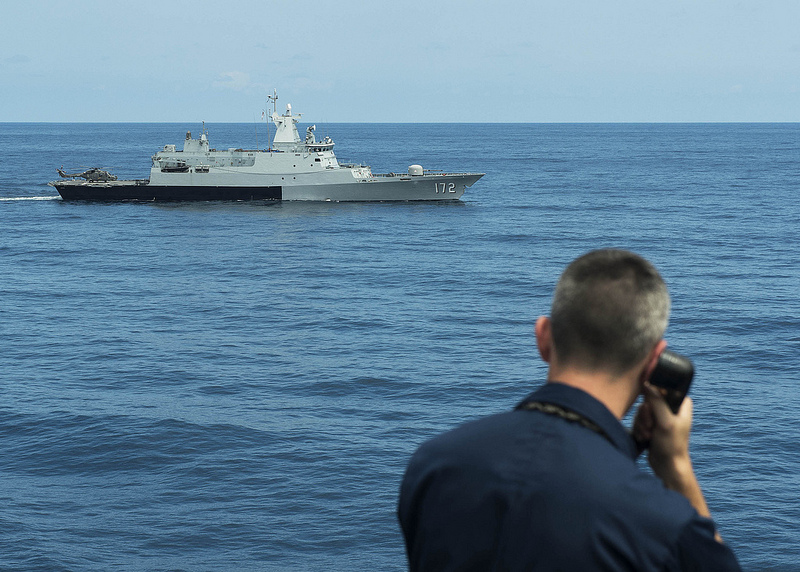At the recent U.S.-ASEAN leaders’ summit in Sunnylands, President Barack Obama spoke of the two sides advancing their “shared vision of a regional order where international rules and norms, including freedom of navigation, are upheld and where disputes are resolved through peaceful, legal means.” The oblique reference to the South China Sea was a declaration that the United States would not stand by idly as China unilaterally changed the maritime status quo, but tensions have only risen in the days since.
Apprehensions over the South China Sea dispute are born from the high stakes involved. Although unlikely, the global economic chaos created by a war in East and Southeast Asia would be unimaginable, and would result in decades of human tragedy. Even a comparatively minor conflict could bring world trade — 50 percent of which passes through the region — to a jarring halt.
To many in Washington and Beijing, the South China Sea dispute has become a proxy battle for influence over Asia. But ASEAN, arguably the second most successful regional organization in the world after the European Union, has a pivotal role to play in this contest. It will take careful engagement from all three parties to resolve the disputes peacefully. Ultimately, the South China Sea dispute poses three distinct tests for these players. They are the rules and norms test, the resource management test, and the operational test.
The rules and norms test requires China to respect international law when addressing the South China Sea dispute. As a peaceful and responsible permanent member of the Security Council, China – which has judges sitting in the International Court of Justice and the International Tribunal for the Law of the Sea – must not use the threat or use of force in the resolution of the maritime dispute. The world needs assurance that the newly-built islands in the South China Sea are not being militarized or used for power projection in the region.
The United States, which promotes freedom of navigation and adherence to global norms, must lead by example. The principal and most effective way to do this would be by ratifying the United Nations Convention on the Law of the Sea (UNCLOS). America’s credibility in advocating that nations abide by the principle of freedom of navigation and the law of the sea is reduced when Washington itself refuses to be party to the Constitution of the Ocean, UNCLOS. The deteriorating situation in the South China Sea provides a much-needed push for the United States to get its act together.
Members of ASEAN involved in the dispute must shore up the importance of rules and norms, too. Smaller nations dealing with larger ones must rely on international norms and rules to advocate for themselves. To accomplish this, parties in the South China Sea dispute that have not done so need to streamline their claims under international law. They must state clearly the features, the names, the exact location, and the legal basis of their claims. Practices incompatible with UNCLOS, such as Vietnam’s excessive baselines, need to be ended.
The resource management test requires the claimants themselves, the greater ASEAN community, and possibly the United States to collaborate on the conservation of marine resources in the South China Sea. The non-existence of a regional fisheries management organization in the disputed area has led to the absence of information on the depletion of fish stocks and deterioration of the health of the sea. This could lead to food insecurity, the increasing poverty of coastal communities, and increasing illegal, unreported and unregulated fishing.
While the idea of joint development of mineral resources is wishful thinking, the six countries of the Coral Triangle Initiative—two of which, Malaysia and the Philippines, are South China Sea claimants—have demonstrated that collaboration to manage the health of the largest coral reef on earth is possible without having a settled maritime boundary. The security, safety, and environmental management of the Straits of Malacca and Singapore do not require a definitive maritime boundary or even the successful settlement of sovereignty disputes.
The organizational test requires the United States, ASEAN, and China to devise a mechanism to reduce the risk of collision or conflict at sea. The ASEAN Defense Ministers’ Meeting can be an excellent platform to establish a practical mechanism aimed at defusing tensions, preventing escalation, managing maritime emergencies, and increasing operational safety. The three parties could establish sub-regional naval collaboration for joint exercises and joint operations other than war to create, strengthen, and maintain trust. The sharing of experiences in regional maritime law enforcement could also create the needed trust.
No one country can handle myriad global threats or the burden of international order all by itself; not even the collective power of all five permanent members of the Security Council can do so. International challenges require international cooperation and solutions.
Passing each of these three tests is needed to avoid an Asian tragedy from emerging in the South China Sea.
This essay originally appeared on CogitAsia, a blog of the CSIS Asia Program.
